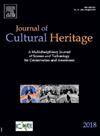Lac dye colours: A review of the origin, history and identification techniques in textiles
IF 3.3
2区 综合性期刊
0 ARCHAEOLOGY
引用次数: 0
Abstract
Lac dye, the dyestuff derived from Kerria scale insects, has been valued for millennia by various civilizations, which have appreciated its deep red shades in textiles, paintings, and other cultural artefacts. The colour derived from lac dye is complex both in structure and history, and has been the topic of numerous discussions addressing its origin, history and multiple uses as a dyestuff, medicine or cosmetic. However, there is still a significant lack of cohesion between sources, and no publication to date has offered a comprehensive overview of lac dye. This review aims to fill this knowledge gap by exploring the biological sources from which lac dye derives; the historical importance in Asia and the Mediterranean area; and the variety of processing techniques according to technical written sources. Particular attention is given to the use of lac dye on textiles by comparing the existing dyeing manuals and identification in historical textiles by analytical methods such as high-performance liquid chromatography (HPLC) coupled to diode array (DAD) and mass spectrometry (MS) detectors or surface-enhanced Raman spectroscopy (SERS). The review also offers an updated overview on the taxonomy of Kerria lac insects, highlighting their geographical diversity and suggesting future perspective of research. The discussion provides new insights into the complexity of lac dye and its use in the dyeing traditions worldwide, by intersecting sources from history, science and art.
紫胶染料:纺织品中紫胶染料的起源、历史和鉴定技术综述
紫胶染料是一种从紫胶蚧虫中提取的染料,几千年来一直受到各种文明的重视,它们在纺织品、绘画和其他文化文物中都欣赏它的深红色。紫胶染料衍生的颜色在结构和历史上都很复杂,并且已经成为许多讨论的主题,涉及其起源,历史和作为染料,医药或化妆品的多种用途。然而,来源之间仍然明显缺乏凝聚力,迄今为止没有出版物提供了紫胶染料的全面概述。本文旨在通过探索紫胶染料的生物来源来填补这方面的知识空白;在亚洲和地中海地区的历史重要性;并根据各种加工工艺写成技术资料。特别关注lac染料在纺织品上的使用,通过比较现有的染色手册和通过高效液相色谱(HPLC)耦合二极管阵列(DAD)和质谱(MS)探测器或表面增强拉曼光谱(SERS)等分析方法对历史纺织品进行鉴定。本文还介绍了紫紫昆虫分类学的最新概况,强调了紫紫昆虫的地理多样性,并提出了今后的研究方向。通过历史、科学和艺术的交叉来源,讨论提供了对紫胶染料的复杂性及其在世界各地染色传统中的使用的新见解。
本文章由计算机程序翻译,如有差异,请以英文原文为准。
求助全文
约1分钟内获得全文
求助全文
来源期刊

Journal of Cultural Heritage
综合性期刊-材料科学:综合
CiteScore
6.80
自引率
9.70%
发文量
166
审稿时长
52 days
期刊介绍:
The Journal of Cultural Heritage publishes original papers which comprise previously unpublished data and present innovative methods concerning all aspects of science and technology of cultural heritage as well as interpretation and theoretical issues related to preservation.
 求助内容:
求助内容: 应助结果提醒方式:
应助结果提醒方式:


